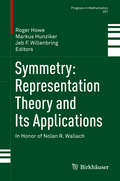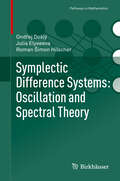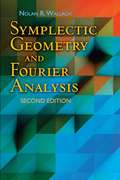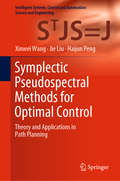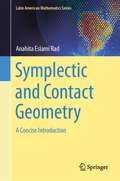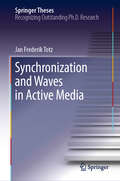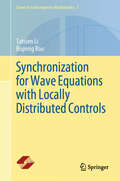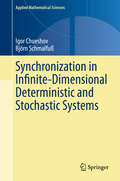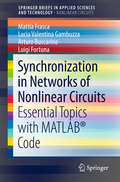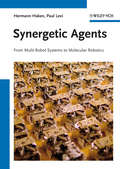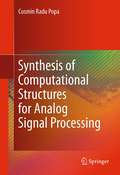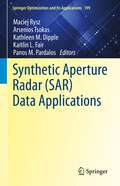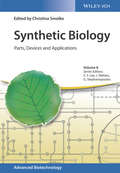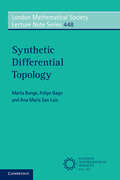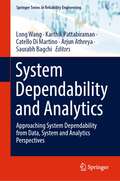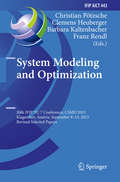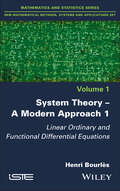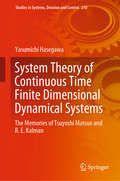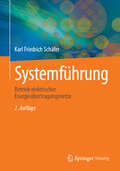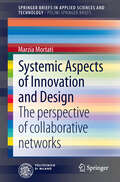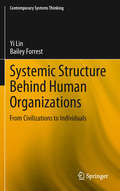- Table View
- List View
Symmetry: Representation Theory and Its Applications
by Roger Howe Markus Hunziker Jeb F. WillenbringNolan Wallach's mathematical research is remarkable in both its breadth and depth. His contributions to many fields include representation theory, harmonic analysis, algebraic geometry, combinatorics, number theory, differential equations, Riemannian geometry, ring theory, and quantum information theory. The touchstone and unifying thread running through all his work is the idea of symmetry. This volume is a collection of invited articles that pay tribute to Wallach's ideas, and show symmetry at work in a large variety of areas. The articles, predominantly expository, are written by distinguished mathematicians and contain sufficient preliminary material to reach the widest possible audiences. Graduate students, mathematicians, and physicists interested in representation theory and its applications will find many gems in this volume that have not appeared in print elsewhere. Contributors:D. Barbasch, K. Baur, O. Bucicovschi, B. Casselman, D. Ciubotaru, M. Colarusso, P. Delorme, T. Enright, W. T. Gan, A Garsia, G. Gour, B. Gross, J. Haglund, G. Han, P. Harris, J. Hong, R. Howe, M. Hunziker, B. Kostant, H. Kraft, D. Meyer, R. Miatello, L. Ni, G. Schwarz, L. Small, D. Vogan, N. Wallach, J. Wolf, G. Xin, O. Yacobi.
Symplectic Difference Systems: Oscillation and Spectral Theory (Pathways in Mathematics)
by Ondřej Došlý Julia Elyseeva Roman Šimon HilscherThis monograph is devoted to covering the main results in the qualitative theory of symplectic difference systems, including linear Hamiltonian difference systems and Sturm-Liouville difference equations, with the emphasis on the oscillation and spectral theory. As a pioneer monograph in this field it contains nowadays standard theory of symplectic systems, as well as the most current results in this field, which are based on the recently developed central object - the comparative index. The book contains numerous results and citations, which were till now scattered only in journal papers. The book also provides new applications of the theory of matrices in this field, in particular of the Moore-Penrose pseudoinverse matrices, orthogonal projectors, and symplectic matrix factorizations. Thus it brings this topic to the attention of researchers and students in pure as well as applied mathematics.
Symplectic Geometry and Fourier Analysis: Second Edition (Dover Books on Mathematics #Vol. 5)
by Nolan R. WallachThis book derives from author Nolan R. Wallach's notes for a course on symplectic geometry and Fourier analysis, which he delivered at Rutgers University in 1975 for an audience of graduate students in mathematics and their professors. The monograph is geared toward readers who have taken a basic course in differential manifolds and elementary functional analysis. The first chapters cover certain geometric preliminaries, advancing to discussions of symplectic geometry and the application of its concepts to the action of a Lie group on a symplectic manifold. Subsequent chapters address Fourier analysis, the metaplectic representation, and quantization. A final chapter on the Kirillov theory applies the ideas of the previous chapters to homogeneous symplectic manifolds of nilpotent Lie groups. The book concludes with an Appendix on Quantum Mechanics by Robert Hermann.
Symplectic Integration of Stochastic Hamiltonian Systems (Lecture Notes in Mathematics #2314)
by Jialin Hong Liying SunThis book provides an accessible overview concerning the stochastic numerical methods inheriting long-time dynamical behaviours of finite and infinite-dimensional stochastic Hamiltonian systems. The long-time dynamical behaviours under study involve symplectic structure, invariants, ergodicity and invariant measure. The emphasis is placed on the systematic construction and the probabilistic superiority of stochastic symplectic methods, which preserve the geometric structure of the stochastic flow of stochastic Hamiltonian systems. The problems considered in this book are related to several fascinating research hotspots: numerical analysis, stochastic analysis, ergodic theory, stochastic ordinary and partial differential equations, and rough path theory. This book will appeal to researchers who are interested in these topics.
Symplectic Pseudospectral Methods for Optimal Control: Theory and Applications in Path Planning (Intelligent Systems, Control and Automation: Science and Engineering #97)
by Xinwei Wang Jie Liu Haijun PengThe book focuses on symplectic pseudospectral methods for nonlinear optimal control problems and their applications. Both the fundamental principles and engineering practice are addressed. Symplectic pseudospectral methods for nonlinear optimal control problems with complicated factors (i.e., inequality constraints, state-delay, unspecific terminal time, etc.) are solved under the framework of indirect methods. The methods developed here offer a high degree of computational efficiency and accuracy when compared with popular direct pseudospectral methods. The methods are applied to solve optimal control problems arising in various engineering fields, particularly in path planning problems for autonomous vehicles. Given its scope, the book will benefit researchers, engineers and graduate students in the fields of automatic control, path planning, ordinary differential equations, etc.
Symplectic and Contact Geometry: A Concise Introduction (Latin American Mathematics Series)
by Anahita Eslami RadThis textbook offers a concise introduction to symplectic and contact geometry, with a focus on the relationships between these subjects and other topics such as Lie theory and classical mechanics. Organized into four chapters, this work serves as a stepping stone for readers to delve into the subject, providing a succinct and motivating foundation. The content covers definitions, symplectic linear algebra, symplectic and contact manifolds, Hamiltonian systems, and more. Prerequisite knowledge includes differential geometry, manifolds, algebraic topology, de Rham cohomology, and the basics of Lie groups. Quick reviews are included where necessary, and examples and constructions are provided to foster understanding. Ideal for advanced undergraduate students and graduate students, this volume can also serve as a valuable resource for independent researchers seeking a quick yet solid understanding of symplectic and contact geometry.
Synchronization and Waves in Active Media (Springer Theses)
by Jan Frederik TotzThe interplay between synchronization and spatio-temporal pattern formation is central for a broad variety of phenomena in nature, such as the coordinated contraction of heart tissue, associative memory and learning in neural networks, and pathological synchronization during Parkinson disease or epilepsy. In this thesis, three open puzzles of fundametal research in Nonlinear Dynamics are tackled: How does spatial confinement affect the dynamics of three-dimensional vortex rings? What role do permutation symmetries play in the spreading of excitation waves on networks? Does the spiral wave chimera state really exist?All investigations combine a theoretical approach and experimental verification, which exploit an oscillatory chemical reaction. A novel experimental setup is developed that allows for studying networks with N > 1000 neuromorphic relaxation oscillators. It facilitates the free choice of network topology, coupling function as well as its strength, range and time delay, which can even be chosen as time-dependent. These experimental capabilities open the door to a broad range of future experimental inquiries into pattern formation and synchronization on large networks, which were previously out of reach.
Synchronization for Wave Equations with Locally Distributed Controls (Series in Contemporary Mathematics #5)
by Tatsien Li Bopeng RaoThis book aims to establish a systematic theory on the synchronization for wave equations with locally distributed controls. It is structured in two parts. Part I is devoted to internal controls, while Part II treats the case of mixed internal and boundary controls. The authors present necessary mathematical formulations and techniques for analyzing and solving problems in this area. They also give numerous examples and applications to illustrate the concepts and demonstrate their practical relevance. The book provides an overview of the field and offers an in-depth analysis of new results with elegant proofs. By reading this book, it can be found that due to the use of internal controls, more deep-going results on synchronization can be obtained, which makes the corresponding synchronization theory more precise and complete. Graduate students and researchers in control and synchronization for partial differential equations, functional analysis find this book useful. It is also an excellent reference in the field. Thanks to the explicit criteria given in this book for various notions of controllability and synchronization, researchers and practitioners can effectively use the control strategies described in this book and make corresponding decisions regarding system design and operation.
Synchronization in Infinite-Dimensional Deterministic and Stochastic Systems (Applied Mathematical Sciences #204)
by Igor Chueshov Björn SchmalfußThe main goal of this book is to systematically address the mathematical methods that are applied in the study of synchronization of infinite-dimensional evolutionary dissipative or partially dissipative systems. It bases its unique monograph presentation on both general and abstract models and covers several important classes of coupled nonlinear deterministic and stochastic PDEs which generate infinite-dimensional dissipative systems. This text, which adapts readily to advanced graduate coursework in dissipative dynamics, requires some background knowledge in evolutionary equations and introductory functional analysis as well as a basic understanding of PDEs and the theory of random processes. Suitable for researchers in synchronization theory, the book is also relevant to physicists and engineers interested in both the mathematical background and the methods for the asymptotic analysis of coupled infinite-dimensional dissipative systems that arise in continuum mechanics.
Synchronization in Networks of Nonlinear Circuits: Essential Topics With Matlab® Code (SpringerBriefs in Applied Sciences and Technology)
by Luigi Fortuna Arturo Buscarino Mattia Frasca Lucia Valentina GambuzzaThis book addresses synchronization in networks of coupled systems. It illustrates the main aspects of the phenomenon through concise theoretical results and code, allowing readers to reproduce them and encouraging readers to pursue their own experimentation. The book begins by introducing the mathematical representation of nonlinear circuits and the code for their simulation. This is followed by a brief account of the concept of the complex network, which describes the main aspects of complex networks and the main model types, with a particular focus on the code used to study and reproduce the models. The focus then shifts to the process through which independent nonlinear circuits that follow different trajectories without coupling share some properties of their motion: synchronization. The authors present the main techniques for studying synchronization in complex networks, including the major measures, the stability properties and control techniques. The book then moves on to advanced topics in synchronization of complex networks by examining forms of synchronization in which not all the units share the same trajectory, namely chimera states, clustering synchronization, and relay and remote synchronization. Simple codes for experimentation with these topics and control methods are also provided. In closing, the book addresses the problem of synchronization in time-varying networks.
Synergetic Agents: From Multi-Robot Systems to Molecular Robotics
by Paul Levi Hermann HakenThis book addresses both multi robot systems and miniaturization to the nanoscale from a unifying point of view, but without leaving aside typical particularities of either. The unifying aspect is based on the concept of information minimization whose precise formulation is the Haken-Levi-principle. The authors introduce basic concepts of multi-component self-organizing systems such as order parameters (well known from equilibrium and non-equilibrium phase transitions) and the slaving principle (which establishes a link to dynamical systems). Among explicit examples is the docking manoeuvre of two robots in two and three dimensions. The second part of the book deals with the rather recently arising field of molecular robotics. It is particularly here where nature has become a highly influential teacher for the construction of robots. In living biological cells astounding phenomena occur: there are molecules (proteins) that literally walk on polymer strands and transport loads that are heavier than their carriers, or molecules that, by joint action, contract muscles. The book provides the reader with an insight into these phenomena, especially by a detailed theoretical treatment of the molecular mechanism of muscle contraction. At the molecular level, for an appropriate approach the use of quantum theory is indispensable. The authors introduce and use it in a form that avoids all the clumsy calculations of wave-functions. They present a model which is based on an elementary version of quantum field theory and allows taking into account the impact of the surrounding on the quantum mechanical activity of a single molecule. By presenting explicit and pedagogical examples, the reader gets acquainted with the appropriate modelling of the walking behaviour of single molecular robots and their collective behaviour. The further development of multi-robot systems and particularly of molecular robots will require the cooperation of a variety of disciplines. Therefore the book appeals to a wide audience including researchers, instructors, and advanced graduate students.
Synthesis of Computational Structures for Analog Signal Processing
by Cosmin Radu PopaSynthesis of Computational Structures for Analog Signal Processing focuses on analysis and design of analog signal processing circuits. The author presents a multitude of design techniques for improving the performances of analog signal processing circuits, and proposes specific implementation strategies that can be used in CMOS technology. The author's discussion proceeds from the perspective of signal processing as it relates to analog. Included are coverage of low-power design, portable equipment, wireless nano-sensors and medical implantable devices. The material is especially appropriate for researchers and specialists in the area of analog and mixed-signal CMOS VLSI design, as well as postgraduate or Ph.D. students working on analog microelectronics.
Synthetic Aperture Radar (Springer Optimization and Its Applications #199)
by Panos M. Pardalos Arsenios Tsokas Maciej Rysz Kathleen M. Dipple Kaitlin L. FairThis carefully curated volume presents an in-depth, state-of-the-art discussion on many applications of Synthetic Aperture Radar (SAR). Integrating interdisciplinary sciences, the book features novel ideas, quantitative methods, and research results, promising to advance computational practices and technologies within the academic and industrial communities. SAR applications employ diverse and often complex computational methods rooted in machine learning, estimation, statistical learning, inversion models, and empirical models. Current and emerging applications of SAR data for earth observation, object detection and recognition, change detection, navigation, and interference mitigation are highlighted. Cutting edge methods, with particular emphasis on machine learning, are included. Contemporary deep learning models in object detection and recognition in SAR imagery with corresponding feature extraction and training schemes are considered. State-of-the-art neural network architectures in SAR-aided navigation are compared and discussed further. Advanced empirical and machine learning models in retrieving land and ocean information — wind, wave, soil conditions, among others, are also included.
Synthetic Biology: Parts, Devices and Applications (Advanced Biotechnology)
by Jens Nielsen Gregory Stephanopoulos Sang Yup Lee Christina Smolkeneed new text The inaugural volume of this new reference work in biotechnology is the most comprehensive of its kind on the market, covering everything from DNA synthesis to RNA interference and biosensors. Edited by the renowned scientists Sven Panke of the Swiss Federal Institute of Technology and Christina Smolke from Stanford University.
Synthetic Differential Topology (London Mathematical Society Lecture Note Series #448)
by Marta Bunge Felipe Gago Ana María San LuisThis book formally introduces synthetic differential topology, a natural extension of the theory of synthetic differential geometry which captures classical concepts of differential geometry and topology by means of the rich categorical structure of a necessarily non-Boolean topos and of the systematic use of logical infinitesimal objects in it. Beginning with an introduction to those parts of topos theory and synthetic differential geometry necessary for the remainder, this clear and comprehensive text covers the general theory of synthetic differential topology and several applications of it to classical mathematics, including the calculus of variations, Mather's theorem, and Morse theory on the classification of singularities. The book represents the state of the art in synthetic differential topology and will be of interest to researchers in topos theory and to mathematicians interested in the categorical foundations of differential geometry and topology.
System Dependability and Analytics: Approaching System Dependability from Data, System and Analytics Perspectives (Springer Series in Reliability Engineering)
by Long Wang Karthik Pattabiraman Catello Di Martino Arjun Athreya Saurabh BagchiThis book comprises chapters authored by experts who are professors and researchers in internationally recognized universities and research institutions. The book presents the results of research and descriptions of real-world systems, services, and technologies. Reading this book, researchers, professional practitioners, and graduate students will gain a clear vision on the state of the art of the research and real-world practice on system dependability and analytics. The book is published in honor of Professor Ravishankar K. Iyer, the George and Ann Fisher Distinguished Professor in the Department of Electrical and Computer Engineering at the University of Illinois at Urbana-Champaign (UIUC), Urbana, Illinois. Professor Iyer is ACM Fellow, IEEE Fellow, AAAS Fellow, and served as Interim Vice Chancellor of UIUC for research during 2008–2011. The book contains chapters written by many of his former students.
System Identification Using Regular and Quantized Observations
by Le Yi Wang George G. Yin Qi HeThis brief presents characterizations of identification errors under a probabilistic framework when output sensors are binary, quantized, or regular. By considering both space complexity in terms of signal quantization and time complexity with respect to data window sizes, this study provides a new perspective to understand the fundamental relationship between probabilistic errors and resources, which may represent data sizes in computer usage, computational complexity in algorithms, sample sizes in statistical analysis and channel bandwidths in communications.
System Identification, Environmental Modelling, and Control System Design
by Hugues Garnier Liuping WangThis book is dedicated to Prof. Peter Young on his 70th birthday. Professor Young has been a pioneer in systems and control, and over the past 45 years he has influenced many developments in this field. This volume comprises a collection of contributions by leading experts in system identification, time-series analysis, environmetric modelling and control system design - modern research in topics that reflect important areas of interest in Professor Young's research career. Recent theoretical developments in and relevant applications of these areas are explored treating the various subjects broadly and in depth. The authoritative and up-to-date research presented here will be of interest to academic researcher in control and disciplines related to environmental research, particularly those to with water systems. The tutorial style in which many of the contributions are composed also makes the book suitable as a source of study material for graduate students in those areas.
System Modeling and Optimization
by Christian Pötzsche Clemens Heuberger Barbara Kaltenbacher Franz RendlThis book is a collection of thoroughly refereed papers presented at the 26th IFIP TC 7 Conference on System Modeling and Optimization, held in Klagenfurt, Austria, in September 2013. The 34 revised papers were carefully selected from numerous submissions. They cover the latest progress in a wide range of topics such as optimal control of ordinary and partial differential equations, modeling and simulation, inverse problems, nonlinear, discrete, and stochastic optimization as well as industrial applications.
System Theory -- A Modern Approach, Volume 1: Linear Ordinary and Functional Differential Equations
by Henri BourlèsThe theory of dynamic systems is addressed in this book in accordance with the "modern" approach, heir to algebraic analysis, which has been implemented since the last decade of the 20th century. After a reminder of the evolution of the representation of systems based on transfer functions or matrices, the duality of controllability and observability is revisited, and new results are produced concerning time-varying discrete-time systems. To complete and improve the existing analyses, the poles and zeros of linear systems and their interconnections are presented in a new way, as well as the problem of systems governed by functional differential equations (of retarded or neutral type) and their stabilization. This book also proposes known and original mathematical complements.
System Theory of Continuous Time Finite Dimensional Dynamical Systems: The Memories of Tsuyoshi Matsuo and R. E. Kalman (Studies in Systems, Decision and Control #250)
by Yasumichi HasegawaThis book discusses the realization and control problems of finite-dimensional dynamical systems which contain linear and nonlinear systems. The author focuses on algebraic methods for the discussion of control problems of linear and non-linear dynamical systems. The book contains detailed examples to showcase the effectiveness of the presented method. The target audience comprises primarily research experts in the field of control theory, but the book may also be beneficial for graduate students alike.
Systematic Mixed-Methods Research for Social Scientists
by Wendy OlsenThis textbook provides clear and accessible guidance on the importance and practical application of mixed-methods research. Professor Olsen presents a range of multiple mixed-methods techniques using quantified data. Critical realism underpins key arguments. She offers detailed examples based on wide experience with international applied social-science projects. The book shows readers how to join quantitative and qualitative data together. Detailed methods include: using multiple-level data; constructing new indices based on mixing survey responses and personal interviews; and using focus groups alongside a large survey. The book provides readers with linkages of data between different software packages. It explains the analysis stage in mixed-methods research, interprets complex causality, shows how to transform data, and helps with interpreting social structures, institutions, and discourses. Finally, the book covers some epistemological issues. These include the nature and value of data. The author discusses validity and techniques for ensuring relevant, innovative conclusions. The book also touches on action research as an overarching participatory method.This book is based on clear and explicit definitions, is accessible to students and researchers across disciplines, and shows the appeal of mixed-methods research to those trained in quantitative methods.
Systemführung: Betrieb elektrischer Energieübertragungsnetze
by Karl Friedrich SchäferIn diesem Buch werden die wesentlichen Aufgaben der Systemführung von elektrischen Übertragungsnetzen beschrieben. Dazu gehören die Netzführung, die Einhaltung der Systembilanz, die Gewährleistung der Systemsicherheit und die Koordinierung des Stromhandels. Das Buch gibt einen Überblick über den Aufbau und die Struktur von Übertragungsnetzen sowie über deren geschichtliche Entwicklung. Die Einbindung der nationalen Übertragungsnetze in die europäische Verbundsystemführung und in die Sicherheitszentren ist ebenfalls Bestandteil dieses Buches. Es werden der Aufbau und die Aufgaben von Schaltleitungen beschrieben. Die künftige Entwicklung im Bereich der Systemführung wird an den Beispielen neuer Visualisierungskonzepte und kurativem Engpassmanagement skizziert.
Systemic Aspects of Innovation and Design
by Marzia MortatiThe book provides a snapshot of a hot topic - the systemic nature of innovation and its relevance to design - with a trifold perspective: the academic level - the literature on innovation studies and design is often neglected and a clear connection between the two topics taken for granted; the research level - collaborative models are currently considered great opportunities for transforming consumption, production and distribution of goods, but a clear scholarly discourse is still forming; the political level - the European Commission and the OECD are devoting much effort to understanding and measuring the impact of design in innovation processes and firms and a clear contribution would greatly support this path. Thus the book provides an informed, historical and nuanced perspective to the relationship between design and innovation to contribute to all three levels and to propose a point of view that goes beyond aesthetics and meanings.
Systemic Structure Behind Human Organizations
by Bailey Forrest Yi LinSystemic Structure behind Human Organizations: From Civilizations to Individuals shows how the systemic yoyo model can be successfully employed to study human organizations at three different levels: civilizations, business enterprises, and individuals. This monograph tackles managerial problems from an holistic perspective such as how a business entity grows and dies and how a CEO can manipulate the choices of long- and short-term projects in order to gain more control over the board of directors. By creating a uniform language and logic of reasoning, the book provides examples and convincing results. Additionally the book shows how the same model, thinking logic, and methodology of the systems research can be equally applied to analyze problems and situations considered in natural sciences, social sciences, and humanity areas. Therefore it offers knowledge of a brand new tool to attack organizational problems. By concentrating on difficult, unsettled issues in these varying areas, this monograph thoroughly explains how some laws of nature can be established for the common study of natural and social sciences.
